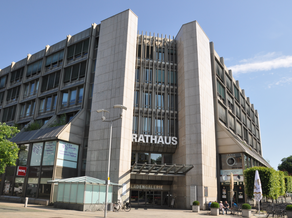Preserving and safeguarding the historical heritage
A wide variety of materials are protected from the "ravages of time" in the City Archive's storerooms. This is achieved above all by optimally adapting the storage conditions to the requirements of the various materials.
Most of the archive material consists of paper, which changes least at a temperature of approx. 20° C and a humidity of approx. 50 %. Photographic stocks require a maximum temperature of 18°C and a humidity of approx. 35%. They are stored in a special magazine (a kind of "walk-in refrigerator").
As a rule, the archive material was not optimally stored before it was transferred to the archive. In everyday office life, materials are used that damage paper in the long term, such as metal in folders or paper clips and plastics with plasticizers in transparent pockets, adhesive strips or loose-leaf binders. These materials must be removed and replaced with durable materials made from special plastics or cardboard - a very time-consuming process.
The archive material was often previously stored in poorly ventilated, dusty cellars and must be carefully cleaned in the archive and, in rare cases, freed from mold or microbial infestation.
One problem with archival documents from the 16th to 19th centuries was the use of acidic ink, which literally ate away at the paper and left frayed holes. Such documents can only be preserved by professional restorers. Photographic media are usually built up in layers. On the carrier is a light-sensitive layer of binder, e.g. gelatine or albumin. This sensitive layer must be particularly well protected, as any chemical change can lead to the loss of the image.
The archive materials are packed in age-resistant folders, sleeves and cardboard boxes suitable for archiving. Age-resistant material is acid-free and has an alkaline reserve that slows down the ageing process. The selection of the right packaging material is facilitated by ISO standards.
The use of cotton gloves in the reading room is recommended to protect the meticulously cleaned, demetallized and archivally packaged documents during use by visitors. Some holdings should no longer be presented in their original form. In this case, microfilming or digitization offer the best possible protection for the valuable originals.



